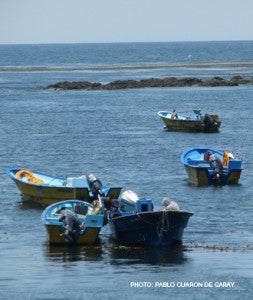 By Sarah Poon
By Sarah Poon
Whether in school, at work, or at play, we’ve all experienced the value of working collectively to achieve a common goal. Many fisheries around the world are successfully managed by providing a structure for collaboration between fishermen via Cooperative catch shares.
In a Cooperative catch share, one or more groups of fishing participants, or “Cooperatives”, are allocated a secure portion of the catch or a dedicated fishing area. In exchange, they are responsible for accepting certain management responsibilities. Many fishing communities around the world have traditionally managed their coastal resources cooperatively, leveraging their local knowledge and relationships to achieve common goals. Recognizing the success of this approach, many fisheries are building upon this traditional practice, while also adapting to the realities of today’s increasingly global fishery markets.
There are hundreds of Cooperatives around the world. They have formed in different ways and have various functions and capacities. But when it comes to their ability to manage fisheries, they share a common (perhaps obvious) theme: Cooperatives work best when people cooperate. Cooperatives have demonstrated that fishermen working together (often hand-in-hand with fishery managers) can improve fishery science, tailor management to local conditions, increase profits and respond to complex management challenges such as discarding and habitat impacts.
Perhaps the most famous example of a well-functioning Cooperative is the United States Bering Sea and Aleutian Island (BSAI) Crab Rationalization Program which is featured on the popular television program, The Deadliest Catch. Prior to Cooperative implementation, fishermen competed with one another in an intense and dangerous race to fish, resulting in overcapitalization, overfishing and unsafe work conditions. Now, under the BSAI Crab Rationalization Program, fishermen are assigned a secure share of the annual catch, and they collaborate rather than compete by sharing information and working together to increase the productivity of their businesses. Because the season is longer and there is no race to fish, fishermen can go out when the weather is fair, avoiding deadly situations.
In the Galicia region of northwestern Spain, artisanal fishermen have worked together for centuries in traditional fishing guilds or “cofradías” to manage the goose barnacle fishery. However, inadequate fishery science and a rise in demand for this traditional culinary delicacy led to a near collapse of the fishery. Recognizing the management potential of the cofradías, the Galician fisheries ministry granted exclusive harvesting privileges—also known as Territorial Use Rights for Fishing (TURFs)—to the traditional fishing guilds. In turn, the cofradías develop annual fishery management plans, participate in monitoring, and ensure sustainable harvest by their members. By working together in their cofradías and alongside fishery managers, fishermen have helped drive the recovery of the goose barnacle population and stabilized profits.
These are just two examples of many fisheries around the world in which a secure stake in the fishery has empowered groups of fishermen to participate in responsible management. Additional stories of fisheries transformed through a Cooperative catch share approach can be found below and as part of our comprehensive fisheries toolkit. Two new guides provide step-by-step guidance to designing Cooperative catch shares, including one for quota-based programs and one for Territorial Use Rights for Fishing.
Japanese Common Fishing Rights System
This program is a model for managing mobile nearshore species through a coordinated system of co-management between federal and regional governments and local fishermen organizations.
Mexican Vigía Chico Cooperative Spiny Lobster Territorial Use Rights for Fishing Program
The most productive fishing Cooperative in the Mexican-Caribbean since 1982, this area-based fishery management program has steadied the Punta Allen lobster catch while most other areas declined.
United States Bering Sea and Aleutian Islands Non-Pollock (Amendment 80) Cooperative Program
A great example of a cooperative catch share, this program ended the race to fish, drastically reduced bycatch rates, and allows slower and more targeting harvesting by fishermen.
United States Central Gulf of Alaska Rockfish Cooperative Program
Launched as a pilot in 2007, the successful rockfish management program was extended for ten years in 2011 years with some key design changes to improve upon the original program design.









